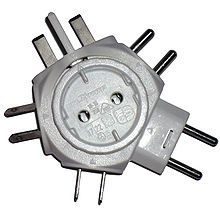Travel plug
A travel plug , travel adapter or socket adapter is used to bridge the differences between different plug systems based on the physical shape or electrical characteristics, so that a connection can be established and the connected electrical device can be operated.
In a simple design, a travel plug can only connect one type of plug to another type of socket . In a more elaborate version, it allows a wide variety of plug types to be connected to a wide variety of socket types.
However, if the differences to be bridged are not only due to different plug and socket types, but also to different mains voltages (e.g. Europe 230 V versus North America 110 V), the travel plug must also contain a transformer so that one is suitable for a mains voltage The device can be operated from a socket with a different mains voltage. Any voltage converter that may be required can also be connected upstream as an external component. Recently, more and more electrical devices have universal power supplies with a wide range input. No transformer is required for these devices.
In addition to the nominal voltage of the electrical device to be operated on the coupling , make sure that the travel plug is also designed for the specified amperage . Another feature that can be important for the safe and proper functioning of electrical devices on the travel plug is the wiring of the protective conductor through the coupling, which connects the operated electrical device to the respective power supply. But it is precisely this feature that is missing from many of the cheap travel plugs that are common in stores. In Figure B, the two plastic bars within the circular top view of the coupling for the Schuko plug (at positions "5 and 11 o'clock") clearly show that this coupling does not have a protective conductor connected in this way. Travel plugs with protective conductor function have wired metal contacts at this point, which are fed through to the international plug-in contacts arranged radially in the picture below.
There are also different mains frequencies , mostly 50 Hz or 60 Hz, which cannot be changed by travel plugs.
Some travel plugs also have a built-in power supply unit with a USB port, which can be used to charge batteries from small devices such as cell phones or cameras.
literature
- Alfred Hösl, Roland Ayx, Hans Werner Busch: The electrical installation in accordance with regulations, residential construction, commercial industry. 18th edition, Hüthig Verlag, Heidelberg, 2003, ISBN 3-7785-2909-9
See also
Web links
- Travel plug at the Bavarian State Ministry of Justice and Consumer Protection in 2009

